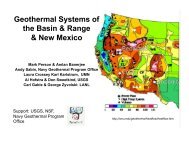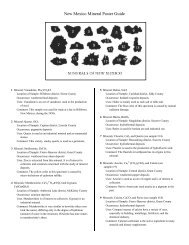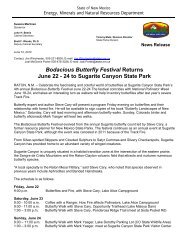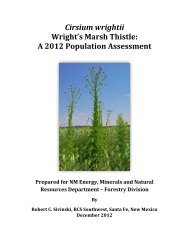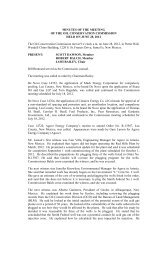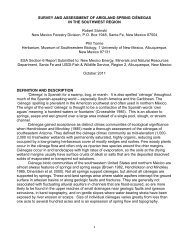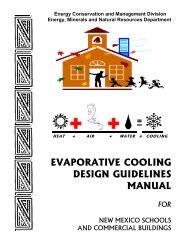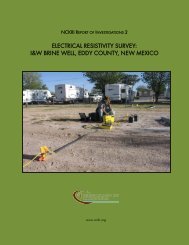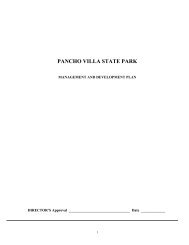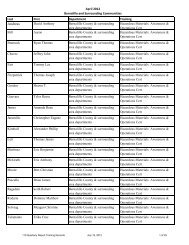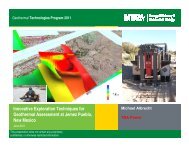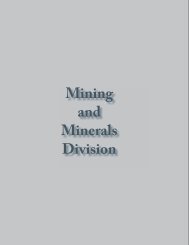Annual Report 3 - New Mexico - Energy, Minerals and Natural ...
Annual Report 3 - New Mexico - Energy, Minerals and Natural ...
Annual Report 3 - New Mexico - Energy, Minerals and Natural ...
Create successful ePaper yourself
Turn your PDF publications into a flip-book with our unique Google optimized e-Paper software.
100<br />
The Surface Owners’ Protection Act was adopted in 2007. Under the act:<br />
Surface owners who do not own the mineral rights below their property must be notified 30 days prior to<br />
beginning any drilling-related operations.<br />
Surface owners must receive a description of proposed oil <strong>and</strong> gas operations so they can evaluate the<br />
potential impacts to their property.<br />
Oil <strong>and</strong> gas operators must compensate l<strong>and</strong>owners for the use of their property, <strong>and</strong> pay for any damages<br />
caused by activities like drilling <strong>and</strong> road building.<br />
The act also requires oil <strong>and</strong> gas operators to clean up after themselves when they are finished.<br />
Previous law required no prior notice of operations to the surface owner. By passing the Surface Owners’ Protection<br />
Act, <strong>New</strong> <strong>Mexico</strong> became the only state to require companies to provide l<strong>and</strong>owners with extensive information<br />
about pending oil <strong>and</strong> gas drilling. <strong>New</strong> <strong>Mexico</strong> also became the only state to m<strong>and</strong>ate compensation for such a<br />
broad range of damages <strong>and</strong> use, including loss of agricultural production <strong>and</strong> income, reduced l<strong>and</strong> value, lost use,<br />
<strong>and</strong> access to the surface owner’s l<strong>and</strong>. Combined with the duty to reclaim the l<strong>and</strong> once oil <strong>and</strong> gas operations have<br />
ceased, this is the most complete set of surface owner protections in the country. This act made the responsibilities of<br />
l<strong>and</strong> owners <strong>and</strong> of the oil <strong>and</strong> gas well operators more clear <strong>and</strong> provided a vehicle for more effective communication.<br />
OCD’s Environmental Bureau led a task force of members from the industry, the public, other government entities<br />
<strong>and</strong> other interested parties to create a rule to replace the existing pit rule. Pits are used to contain fluids resulting<br />
from drilling <strong>and</strong> other oil <strong>and</strong> gas operations to prevent those fluids from contaminating ground water or harming<br />
wildlife. Topics considered included st<strong>and</strong>ards for pit installations <strong>and</strong> closures, the lining of pits, soil testing,<br />
fencing <strong>and</strong> netting, <strong>and</strong> best practices. This rule became effective in 2008. The division conducted training sessions<br />
throughout the state. Later the pit rule was revised to gr<strong>and</strong>father in certain types of tanks to minimize conversion<br />
costs to the industry.<br />
In 2008, OCD <strong>and</strong> the Oil Conservation Commission restructured <strong>and</strong> revised their rules to make them easier to<br />
read <strong>and</strong> to use. The changes included restructuring the rules under 33 headings accurately reflecting the subject<br />
matter, adopting consistent use of terms throughout the rules, changing rules related to OCD forms to reflect current<br />
requirements <strong>and</strong> practices <strong>and</strong> corrections to information that had become inconsistent due to updates over the<br />
years.<br />
Last, a rule to protect the unique nature of the Galisteo Basin was adopted by the Oil Conservation Commission.<br />
ENFORCEMENT: The division refined its enforcement rules with changes that went into effect over<br />
several years. These rules provide a means for well operators <strong>and</strong> OCD to consistently determine whether an<br />
operator is compliant or non-compliant with division rules in the areas of well inactivity, financial assurance,<br />
operatorship <strong>and</strong> meeting the requirements of division orders. Information that determines current <strong>and</strong> future noncompliance<br />
is displayed on OCD’s web site <strong>and</strong> updated daily to allow all parties to take early action <strong>and</strong> to provide<br />
assurance that enforcement is equitable.<br />
ENERGY, MINERALS AND NATURAL RESOURCES DEPARTMENT




